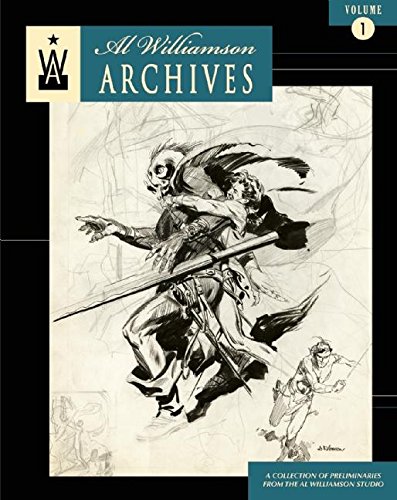
To be a Xenozoic Tales fan is to be patient. Since its debut in Death Rattle #8 in 1986, Mark Schultz’s post-apocalyptic adventure series has had an irregular release schedule, and been left with an open cliffhanger since the publication of Xenozoic Tales #14 in 1996. Which isn’t meant to imply that Schultz hasn’t released other work in the years since. His recent projects include the lushly illustrated novella Storms at Sea, the four-volume Carbon series collecting his illustration work, the educational graphic novel The Stuff of Life (illustrated by Zander and Kevin Cannon), and, since 2004, he has written the Prince Valiant comic strip (initially with Gary Gianni, and now with Thomas Yeates handling art).
The last time The Comics Journal spoke to Mark Schultz was in issue #150, May of 1992, when Xenozoic Tales was being regularly published by Kitchen Sink Press. It seemed like a catch-up was long overdue.
-Jason Bergman
* * *
Let’s start with Xenozoic Tales. Was that initial story in Death Rattle your first professional comics work?
I'm trying to think. I had sent my sample of Xenozoic to Kitchen Sink and a number of other different companies. Kitchen Sink was the only company interested in publishing it, so I was very excited about that. They wanted me to do a short piece that would fit into Death Rattle, something more of a horrific nature. At about the same time I got a job inking a backup story in Marvel's Conan magazine Savage Sword of Conan. Actually, the first thing that I believe that was published was that ink job I did, over Val Semeiks’ pencils in Conan, but then the first of my own work was the Xenozoic story in Death Rattle #8.
When you did that first story, did you have any long-term plans for the world or the characters, or was it just a collection of things you were interested in?
No, I had worked [it] out. I'd been developing the concept for Xenozoic for years and years while I was doing freelance illustration and working as a security guard. So I had lots of time to just mull over what I'd like to do if I had my own comic, I had a pretty good idea where I wanted to go. Now the specifics, the actual plot lines of various stories weren't there yet.
You were building out the world and taking notes and that sort of thing?
I had the world fleshed out reasonably well, yeah.
I don't want to dwell too much on that era of Xenozoic Tales, because it was covered in the previous Comics Journal interview, which was 1992.
Yeah, how about that? Jeez.
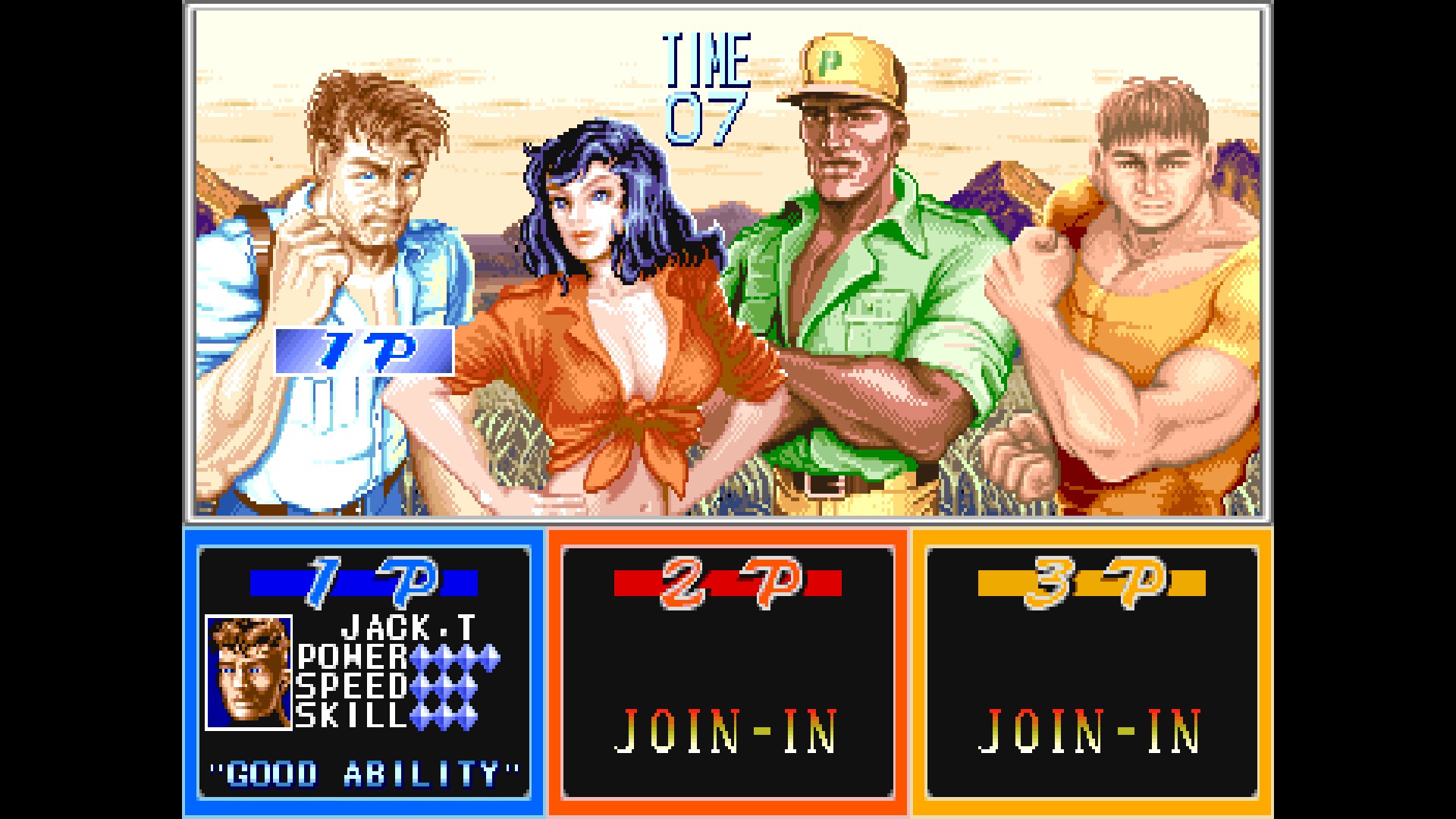
But I do want to touch on that exact time period, because 1992 was really interesting for Xenozoic Tales, and that interview was interesting to go back and read. In 1992, the cartoon show hadn't aired yet, but you talked about how the deals were out there. At that point, there were video games, there was a Saturday morning cartoon show, Marvel published colorized reprints, and there was a movie in production even.
No, no. There was never a movie in production.
You talk about it in the interview! You said that the rights had been sold to a production company, and that they were pursuing--
Oh, I guess maybe at that point that was what they were talking about. It evolved into the television show. It never got beyond the "This is what we'd like to do with it” [stage]. It became the animated cartoon show on CBS. That's what that evolved into.
What was that whole time like for you? You were mostly hands-off, I assume, during all that.
Yeah. Well, I learned pretty quickly that when you get that kind of money involved, those kind of corporate players involved, it's not a good use of your time to try to fight if you don't... or have the fantasy that you can guide things. They have their idea of what's going to sell based on their experience and their belief system and whatnot. You're going to be viewed as an impediment more than anything, I think. I learned pretty quickly. It was a better use of my time to just concentrate on my own work and things I could control.
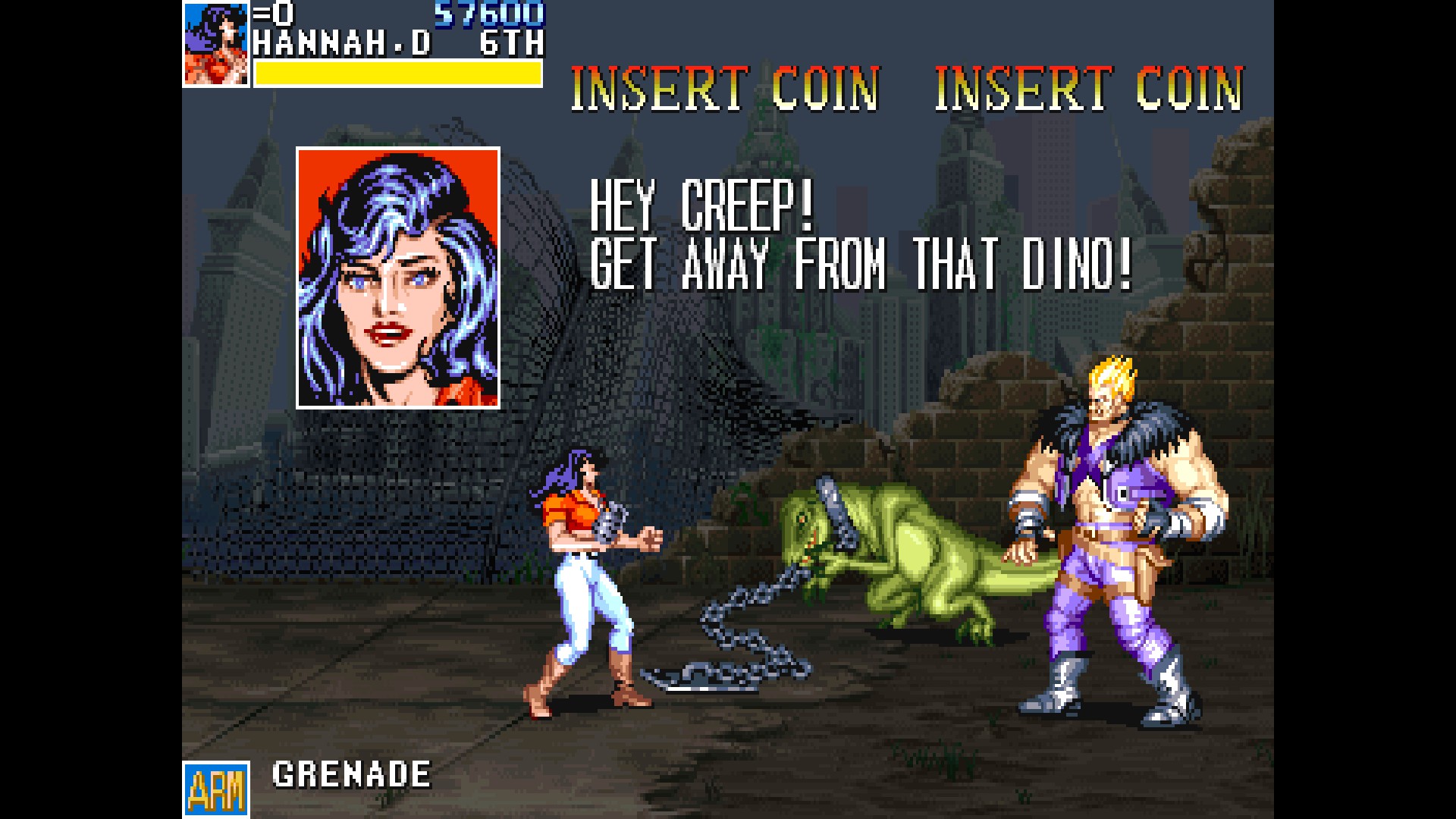
What was your opinion of the things that were made? I guess there was the video games and then there was the cartoon show.
Well, I don't know what to say about the video games, because I have not played a single video game in my life. I've had six year-olds try to teach me how to play games and they’ve become frustrated with me in a matter of minutes, for my lack of ability to work the controls. [laughs] I've been told that the Capcom game which was an arcade game was a better than average game. It still has I guess some sort of following.
The game that was made for Sega, a company called Rocket Science out of San Francisco, that died on the vine, I believe. They put it out at the same time that Sega was turning its platform to Sega Saturn. You know more about this than I do.
That is accurate, yeah. It was a Sega CD title released at the tail end of that era, and it was a victim of very bad timing.
Bad timing, yes. I think that company released three or four games at the same time, and I think it was an antiquated platform I guess as soon as they released them. The TV show, I was just going to say I never know what to tell people about this. I know people seem to have liked it for what it was, and it certainly has brought new generations to my book, back to Xenozoic Tales, but man, I'm just too close to the material to really be able to look at it without wincing. I think for a Saturday morning cartoon show it's probably a good show, but again I'm just too close to it to be an objective observer.
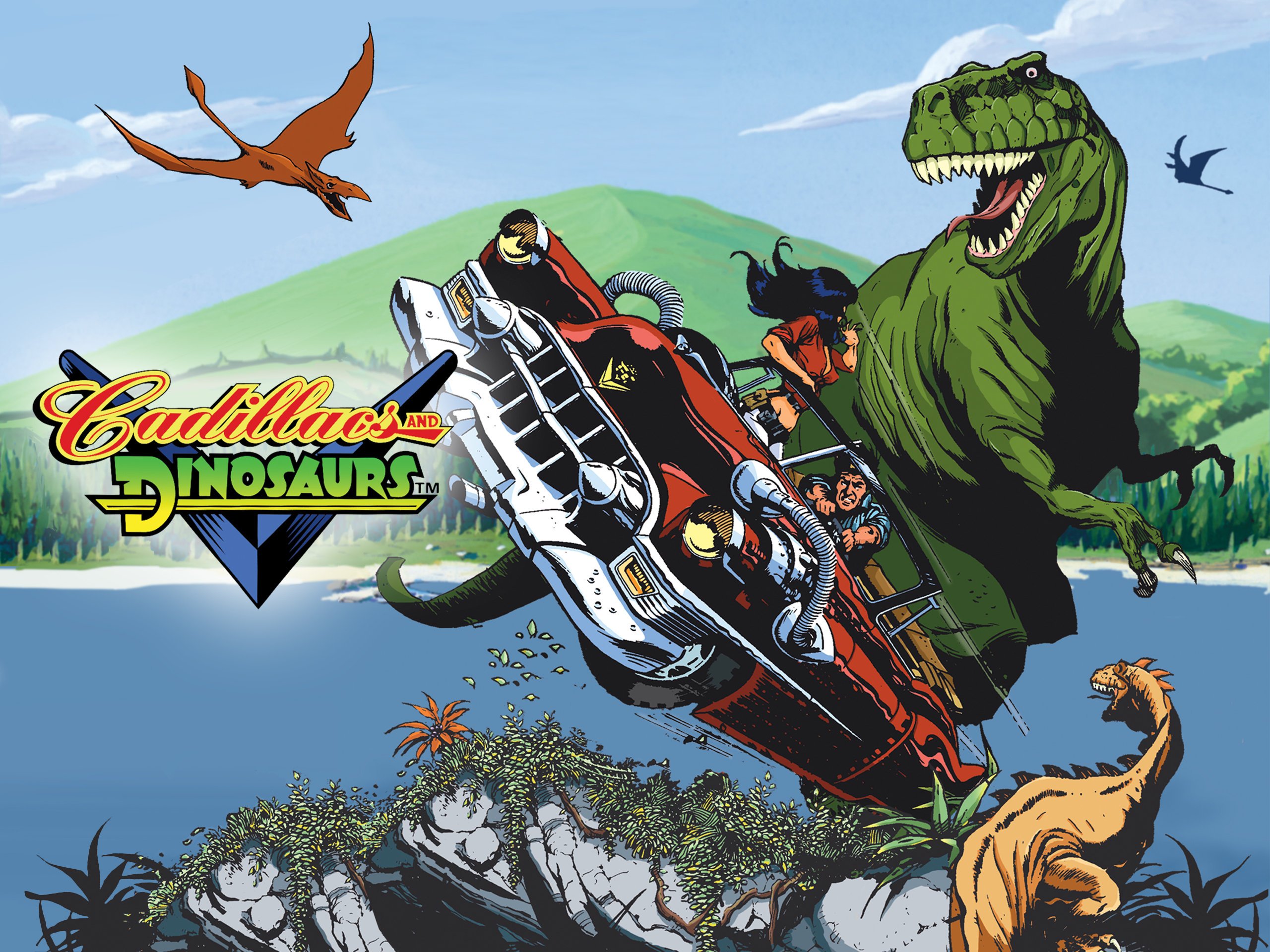
Is the name Cadillacs and Dinosaurs specific to that era? Are you trying to separate yourself from that?
It's what it is. It's a good thing if it brings people around to my work, but yes I don't use the name Cadillacs and Dinosaurs anymore. And one reason is that we entered into an agreement with General Motors who owns the name Cadillac as regards to being used as an automobile. Since we were using the image of the actual Cadillac car in my work when we went to actually market stuff, merchandise things, we had to reach an agreement with them that we could use the name Cadillac. That agreement has expired. I have no right to use it anymore regardless.
You can still refer to the character as Cadillac, I'm assuming.
Yes, but I haven't in years. That was something I think I used in the first few issues of Xenozoic; he was referred as Cadillac. I don't know, I just dropped that along the way.
It is still in the most recent reproductions though?
Oh yes, yes, yes. That's okay within the context. My understanding of the difference between copyright and trademark and what is permissible is I can refer to him as Cadillac within the body of the work, I just can't promote it in the title or use it for any merchandising or marketing. To nickname someone Cadillac, that's been used by other people many times.
Larry McMurtry, the author who wrote Lonesome Dove and The Last Picture Show, he had a book named Cadillac Jack, which I wasn't even aware of when I named my character Jack “Cadillac” Tenrec. When I learned that there was a book previous to my work, it soured me on using Cadillac in the guy's name because someone else had already gone down that road.
Speaking of the most recent reproduction, my copy of the complete Xenozoic is the first Flesk one. I believe the more recent edition also doesn't have the Steve Stiles backup stories. Are those lost to time?
The stories Steve drew, that’s something that John Fleskes - my publisher - and I would very much like to reprint sometime. John likes to print from original art as much as possible because the technology is there to be able to do that now. The first Flesk edition, it wasn't quite there yet. Long story short, John has been trying to find original pages of Steve’s.

Steve sold off his work, and he died a couple of years ago. His work has been dispersed to the four winds, and occasionally, it'll pop up on an auction site like Heritage, and we try to get scans of it either through Heritage or, with luck, find the person who's purchased the art. At some point, yes, I'm hoping we'll be able to present a massive volume, a more complete volume of all the Xenozoic material, and include Steve's stories because they're an important part of the storytelling and the whole bigger picture of that world.
My bookshelf has the Flesk edition right next to the Kitchen Sink ones, that’s the only way I know of that you can have a complete Xenozoic collection.
Unfortunately, the Kitchen Sink editions do not include, I think, the last two issues of Xenozoic.
Yes, there's overlap there.
Those stories by Steve, the backstories in those two issues have never been reprinted.
Another thing from that Comics Journal interview is you referenced a story that Al Williamson was working on. Was that ever completed or published?
No. Al never finished it. Al started, it was, I believe, a six-page story I wrote. Al penciled it out and inked some of it but Al worked very much, a little bit here, a little bit there. He wasn't a linear cartoonist so there are pages that are pretty finished and there are other pages that are just big blank panels and maybe a few figures penciled in here or there. John Fleskes did a series of books collecting some of Al's work called Al Williamson Archives, back in 2011. Several of Al’s unfinished Xenozoic pages are reproduced in the first volume.
Do you have any plans at any point to maybe finish those in some capacity?
I don't know. That's intimidating.
Do you feel like it would be desecrating his work?
That's what I'm afraid of. That's what's stopping me. Cori Williamson, Al's widow, has asked me, talked to me about doing that. She says she'd like to see it finished. The only way I would do it would be on a separate [board], to print what he's done already on to another board. I wouldn't want to mess up the [same] original boards that he drew on.
Maybe–again, it all comes down to time and economics. It would be a challenge to take on a project like that. Who knows [chuckles] when and how that could happen.
I want to move to Storms at Sea which came out in 2015. I'm a big fan of that, and the tone of that story, and how it touches on classic sci-fi, adventure, and film noir all at the same time.
Thank you.
Is it Xenozoic adjacent or is that just wishful thinking on my part?
No. It's a distinct story, but there are touchpoints in there that you could read into. It references a timeline that could eventually lead to Xenozoic. I was having fun with little Easter egg-type additions. You're on the right track.

Of course, there's the physical characteristics, the characters resembling Xenozoic characters, whether they're distant relatives or--
That might be my limitations as an artist. That's the way I make my heroes and heroines look.
Was it always planned to be prose?
Yes. My brilliant idea was to come up with a format that would allow me to get the story done faster, quicker than the time it takes me to do a comic book. That turned out to be not true, but that was the idea. I thought, I'll do a real old-fashioned picture book with a page of text against an image. If I do it right, the information you get from the text and the information you get from the image will complement each other or sometimes contradict each other, but somehow, they would work together to hopefully flesh out the story more than either alone would.
That was the notion. Again, it wound up taking me just as long as it would've taken me to do a comic book comprised of nothing but panels of art and text via balloons and captions.
Is that because of the detail in the drawings? It's much more detailed than your average comic panel.
Yes, probably. I was trying to teach myself a new technique, which was watercolor, monochromatic watercolor underneath, and then building up layers of charcoal and carbon pencils. I wanted the lush, rich, blacks you can get with carbon pencils. The feeling I was trying to get was that of the classic black and white cinematography from the expressionistic cinematographers like John Alton and [Nicholas] Musuraca, people that were doing this before color became the predominant pallet in films, these rich monochromatic uses of light and shadow.
That's what I was aiming at. It took me [longer] because working with these materials was relatively new for me, it was a plodding process. It was a learning experience, and now I want to take that type of illustration I did in that book and push it further. I'd still want to continue doing those types of illustrations and telling stories that way. Probably not as formal as Storms at Sea, where every spread has one illustration and one block of text–more like a traditional prose novel but with plenty of illustrations.
Is that something you're actively working on or just something you're considering?
I'm [actively] working on it. One of my projects is, I'm working up the outline for the sequel to Storms at Sea, which would be more-- Storms at Sea was more of a setup. There was a lot of backstory there, and not a lot of action or character development. I want the sequel to be more, now that we know the backstory, now that we know the world, I want an involved story that carries things forward with consequences.
So another prose novella with illustrations?
Yes. I think at this point, it would be more like a traditional prose novel but heavily illustrated.
At what point in Storms at Sea did you decide to include a musical score?
The neat thing about this job is that you meet all sorts of great people, interesting people. I have a dear friend, John Christensen, who goes by “Chris,” Christensen, out in California, who is a studio musician and a bandleader. He was a member of the San Diego Comic Convention house band for years, Seduction of the Innocent.
He did an album of Xenozoic music as well, right?
He did the music for the Xenozoic album, correct. He's a multi-talented instrumentalist, but he's also a great composer. Again, because my thought was to reference back to classic film, I wanted an introductory score, rather than a traditional text introduction. Chris was kind enough to come up with this great piano piece.
Which you can listen to online, for anybody who is interested. It almost felt like you should have included, remember flexi discs?
[laughs]. Yes. I wonder if you can get those made anymore. I wonder.
[chuckles] Maybe! Now that vinyl is back, that's a thing. Maybe the era of the Flexi disc is back.
I remember getting those through the mail when I was a kid because they were lightweight. Companies would send those little thin floppy things.
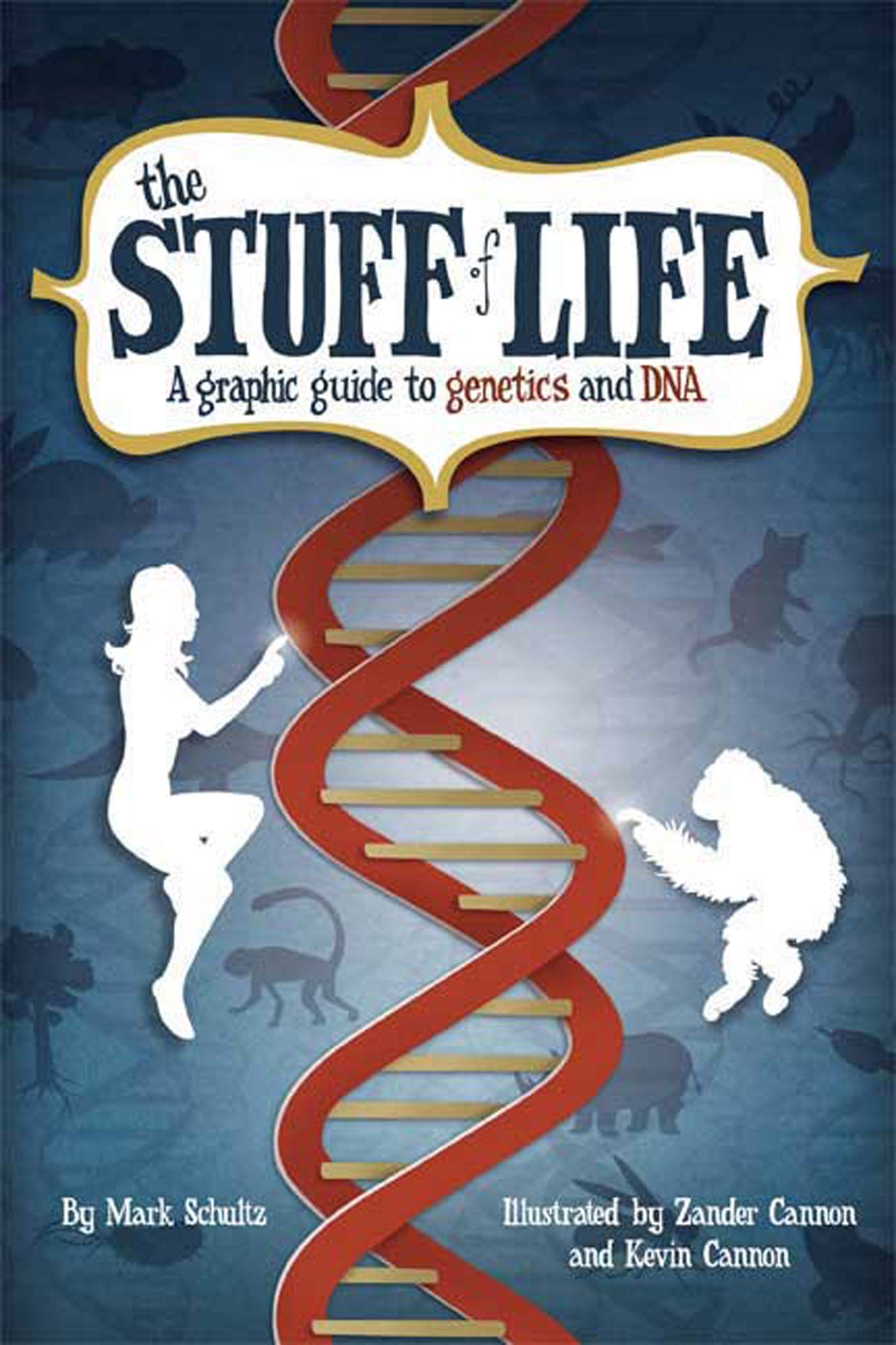
In 2009 you published Stuff of Life, a surprisingly detailed graphic novel about DNA, illustrated by Zander and Kevin Cannon. How did that project come about?
It was through my agent, Judy Hanson. She'd been contacted by Howard Zimmerman, who had done Starlog, if you remember that magazine. [He] was very involved in fandom and science fiction. He got us all together, [and] Judy brought me on board. He'd contacted her and she had recommended me. The publisher wanted a series of books that were graphic novel format and addressed different areas of science, and this was the first of the proposed series. There was some real back and forth between Zander and Kevin and I trying to figure out how do we make this work... we wanted a narrative.
We didn't want to just have a series of facts or a textbook type of format to this, because none of us believed that that's using comics to their best advantage. If you're going to use a comic format it needs to have, we all believed, some sort of narrative structure. It took a little bit of time to convince the publisher to let us use a comedic voice and narrative structure that included this alien we designed to lead the reader through the complexities of genetics and DNA.
They got on board with the idea eventually. I think that really helped us be able to compress information into the relatively limited amount of space you have for such an enormous subject. It also allowed us to use a foil to the narrator– the leader of this alien world that the narrator is reporting to, who is receiving the information about how genetics work on Earth. He's kind of a, well, I won't say dummy, but he's a bit slow on the uptake, [so] we can bounce back information. He asked questions which helped us clarify complexities. He'll question something, so the narrator would go back into it again, and add a little more information just to, hopefully, reinforce [to] the reader what is important to know. That was a year-long project. A lot of research went into that, a lot of [fact] checking.
I was going to say, there must have been significant research involved. When I was reading it I was surprised at how far into the subject you went. It is, I would say, textbook-level information, but in this graphic novel that features asexual aliens getting grossed out by human reproduction.
[Laughs]. It was fun to see how far we could push some of that stuff in an all-ages book. It did take a lot of research. I love science. One of my passions is to learn more about scientific observation and inquiry, but I don't have any bedrock education beyond that of a layman. I would try to triple-check everything I was writing, not just double-check. I tried to find three sources for any information I was putting in there to make sure it was agreed upon and correct and I wasn't misinterpreting or I wasn't going with something that might have been just conjecture at the time.
I was impressed with the fact that you properly credited Rosalind Franklin, and not just Watson and Crick, for the discovery of the double helix.
It was nice to have those little sidebars so I could get into, not just the human interest of it, but the fact that there have been real screw-ups and negative things that have happened in the pursuit of knowledge in these subjects. Not everything is all rosy and good. I enjoyed writing that. I also enjoyed the sidebar about [Trofim] Lysenko, the Soviet pseudo-scientist who, because his genetic theories matched the political agenda of the Stalin administration in the Soviet Union at the time, was able to have enormous influence on agriculture. Which, because his theories were just bullshit, led to horrible famine, horrible crop failure, and just, again, how politics when it gets involved and misrepresents or outright lies about science. And of course we’re seeing anti-science hysteria play out again today with people refusing sensible COVID-19 protocols and opting for magical solutions like Ivermectin.

You said that was originally intended to be part of a series?
Yes, they did one more book, which I wasn't a part of, but Xander and Kevin were. They brought in Jay Hosler, who's a scientist who specializes in bee research, actually. He wrote a great follow-up text, wrote it and the Cannons illustrated it, on evolution. Another beautifully illustrated book, I should say.
Would you ever revisit that kind of thing? Or was that a one-off for you?
Yes, if the conditions were right. Again, it's an enormous amount of time and energy [that] goes into learning something that complex, that you have no expertise in, but boy, it was a lot of fun. I learned a lot and if the situation was right, sure, I'd do it again.
In 2004 you took over writing from Cullen Murphy on Prince Valiant, something you've done ever since. How did that come about?
John Cullen Murphy had been assisted by my friend Gary Gianni on Prince Valiant for a number of years. When John Cullen Murphy retired, Gary took over the principal art chores. John Cullen Murphy's son, Cullen Murphy, had been writing it, writing the script for a couple of decades, I believe. After his father retired, he was looking to move on to other things, too. King Features, which at the time, the editor was Jay Kennedy. On Gary's recommendation, Jay got in touch with me and asked for a few samples of story ideas.

I guess he was happy with what he saw, because he invited me to come on board as a scripter and I've been on board ever since. In 2012, Gary decided to retire from the strip, and Thomas Yeates took over and has been on board ever since.
Were you intimidated at all coming on to the very long-running institution that is Prince Valiant?
Oh yeah, very intimidated. It took me a while to get the nerve up to say, "Yeah, I'd be interested in doing this.'' What mitigates that is the fact that the venues and the formats in which the strip now appears are so different than what Foster had to work with, and for much of the time that the Murphys worked on the script. They had more actual real estate in the papers to work out story and develop the epic feel that is part of the tradition of Prince Valiant. That just doesn't really exist anymore with this space that-
You're referring to the full Sunday page that Hal Foster got to work with.
Or even half a page. Which was common into, I think, the 80’s. It's a different visual goal you have to have in mind because you just don't have the space to do a lot of the beautiful imagery, the traditional classic Prince Valiant as done by Foster, we just don't have the space to do that anymore. It's just another challenge, but knowing this, that did help me get beyond the fact that there was no way I was ever going to, in any regard, be able to compare myself to what Hal Foster did. He's one of the seminal geniuses of comic storytelling, especially in the adventure sense. I have gotten over that but yes, it was intimidating at first.
Your strips tend to be, I guess, three to five panels. That's all you can really squeeze in. Are there beats you try to hit in each week and that you try to tie across a single storyline?
Yeah, absolutely. Generally speaking, you're right, we have between three and six panels generally to work with. The first panel has to be devoted to remind the readers of what happened the previous week. Prince Valiant only appears once a week in the Sunday papers, it's not a daily script. You have to bring the reader back up to speed on what happened last week and then the final panel has to set up where we're going next week, a cliffhanger type of deal. It can be as obvious as an actual cliffhanger: someone's in danger, what's going to happen. Or it could just be a bit of foreshadowing that hopefully is intriguing, that keeps the reader engaged and wanting to come back.
Yes, so that doesn't leave a lot of space in between for actually developing the story. That's where the creativity, the game of it all comes. How do you maximize what you can tell but at the same time, not cram too much in because not only are you limited in how much visual information you can give the reader but you're limited in how much textual information you can squeeze in there as well. The nice thing is both with Gary and now with Thomas, we're all on the same page with our notions of how you tell a story. It's fun to be collaborative, and bounce ideas back and forth.
I will send Thomas my breakdown to say, "Okay, five panels, and this is what has to happen in every panel to advance the story this week." Thomas will come back and say, "Okay, but how about if we do this a little differently, or I choreograph things this way, or we change the emphasis to this and then we can do that?" I'll say, "Oh, that's cool, but maybe we don't want to lose this." We just bounce things back and forth and invariably I think we come up with a better story that way.
When you're plotting out, how far in advance do you have to go? Prince Valiant storylines tend to run for months at a time, just because of the nature of how they're serialized.
Yeah, and that drives some of the readers up the wall that their stories go as long as they do [laughs]. But again, we're working with such a limited amount of space to develop that story every week that we tend to go into the-- I don't know, maybe we do spread out some of the stories too long. It's also a balance between how fast you want to tell the story, but how much information to [give to] individual moments and character development–you want to try to squeeze in there too. But yeah, I will come up with - and I say I, but sometimes it would've been Gary, or now Thomas, comes up with an idea for the arc of a story, just a general, “what if Val has to take a message to somebody in a castle in Scotland and there's some intrigue going on.” Just a general idea.
And then I'll say, "Okay, let me work on that." I'll try to work up something that has more of a specific plot to it, and specific characters. I'll throw that back to him, to the artist. He'll say yay or nay and I’ll work up some more specific weekly breakdowns. In anywhere from four to six to eight week periods, I'll send plots to Thomas and he'll start working on the first one. He'll send me a thumbnail version of the page, a breakdown of the panels in rough sketch form, based on the information I gave him. From that information, I'll write [a] complete script which gets sent back to Thomas to finish the art. Then he sends it on to the letterer and colorist, Scott Roberts.
Do you have a specific type of Prince Valiant story that you think is the quintessential one? There's the long journey story, there's the epic battle story. There's the between battle stories where Val is at home with the family. Do you have a preference for any of those, or for something else?
No, really the neat thing, you're hitting on something that's really fun about the strip. Something that's kept me interested in Prince Valiant is you have all these different story possibilities, and I love the variety of it. We try, we strive for a balance, You have some epic battle, a conflict situation where Val has to be the hero. Then you take a break from that and have some character-oriented pieces where, like you said, maybe he goes back home to his family. And there he’s no longer the leader and the hero and the guy everyone looked to out there in the field– when he gets back home, he's just [an] old dad. He should be helping to do the dishes instead of daydreaming about going drinking with his buddies.
Was that your first story, by the way, the one with Val frustrated at the lack of adventure in his life?
Yes, because he and Aleta had been set up as regents by the Murphys at that point. King Arthur had retired. Val’s wife Aleta, who does have actual administrative experience as the queen of the country she comes from, she makes a good regent. But the name of the strip is Prince Valiant, and Gary and I wanted to get Val back out there having physical adventures. We wanted him back in the field, back out on a horseback, being a knight errant and getting into trouble.
We did that whole thing where he's frustrated and his wife realizes that that's who he is and, basically, he’s no good in court. Even though she might like to have him around the house, that's not who he is. Which actually goes back to Foster, because Foster did this great story in the 50's, back when it was probably the most repressive time in the past century for women, when they were being told after the Second World War to get out to the factories and go back to the kitchen. He writes this great story for Aleta, who's queen of the Misty Isles.
The story revolves around her taking care of a rebellion, taking care of her kingdom. She is the one in charge. She does it all, while Val is watching the kids. Val is the one at home watching the children and then in the end, he's ready to go out and adventure again. She's like, "Okay, that's the deal, I'm not going to sit on him and try to turn him into something he's not." Again, for the 50's, that's brilliant. You weren't seeing that in movies, you weren't seeing that in other comics. That was just brilliant, a bit of egalitarian storytelling from Foster that you don't often see [in] other forms of entertainment at that time.
Your current storyline has Val traveling with Morgan, which feels to me, very classic Prince Valiant. You've got this long journey with an occasional foe.
Thanks. When we decided we wanted to use Morgan le Fay, we did our research [on] what had been done with her previously in the strip, and not that much had been done. Because there's this classic early couple of pages where Val's a prisoner of hers, and this was back [in] 1938 maybe. It's just one of those classic go-to pages or little storylines from Prince Valiant that all fans know. I thought more had been done with her later, but not much had been done. We decided to bring her back because she and Val make for an interesting odd couple type of thing.
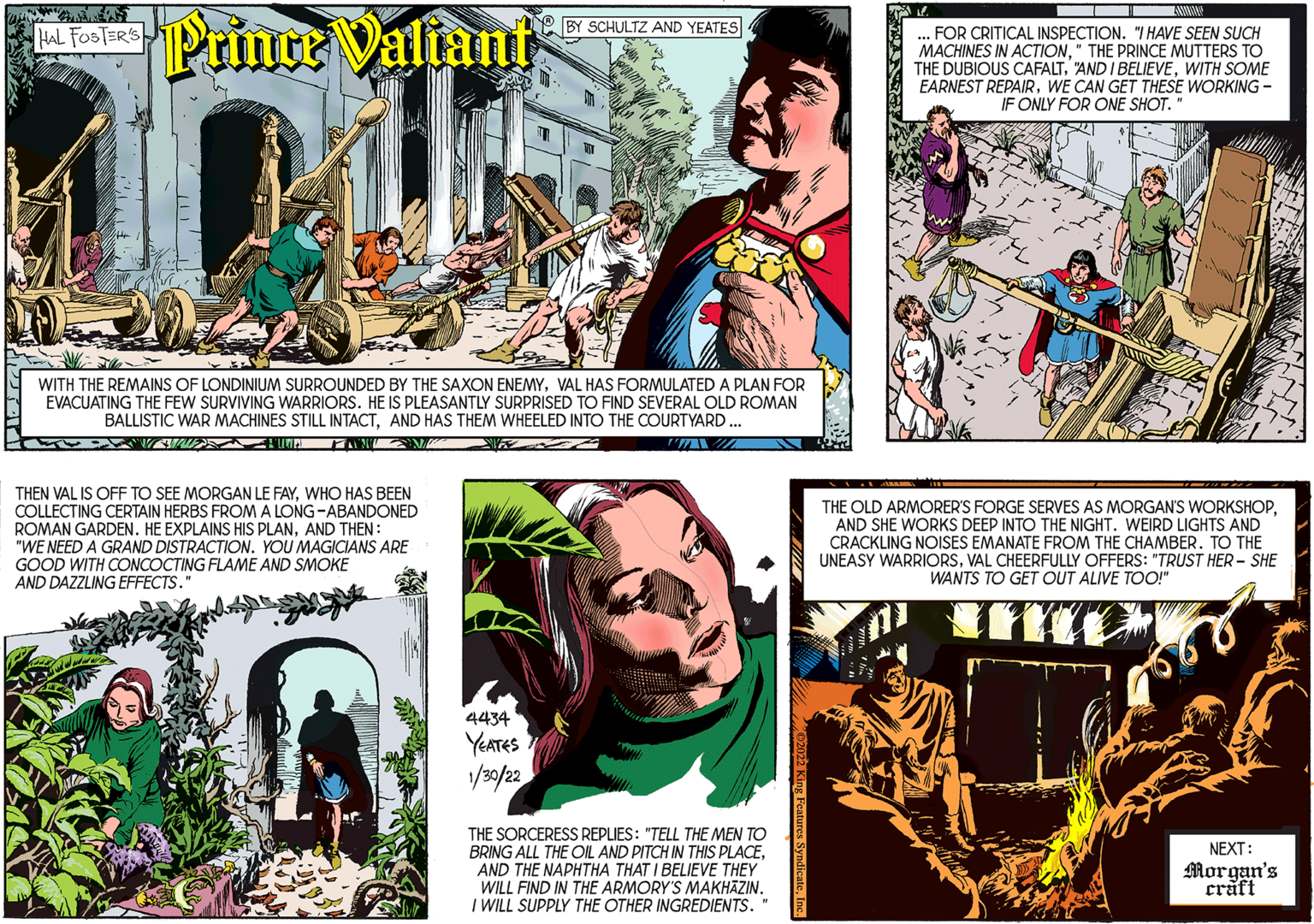
They wind up together on the road and we’ll see where that leads, see what [these] two different temperaments lead to. Of course, as we develop these stories, that was just the initial idea. But then the characters start to take you places that you didn't first consider. It's evolving. It's still an evolving thing. We're having lots of fun with it. [The] interesting thing is, I was researching Morgan le Fay. Most of our understanding of Morgan le Fay as a villainess in the King Arthur cycles comes from the later writers like Mallory.
If you go back to the earliest stories of the whole King Arthur thing, she was the protector. She was his sister–the mythology depends on who’s telling the story. There's a million different variations, but she’s always related to King Arthur. She was his protector. She was a good thing. It was just over time and people evolving the storylines for whatever the contemporary interests were that she was turned more and more into a villain, a seductress and then a villain. I'm interested in making her more ambiguous, getting her back to something that's not..her interest may not be the interest of Camelot, but she's not a villain.
Coming back to your current work, a lot of what you've done lately, at least for me as a fan, has been the Carbon series through Flesk. Are you working on a new one? Will there be a Carbon 5?
Yeah, there will be. I need to have all my work to John, I think we decided in June so it can be published by December. Yes, I am working up drawings right now for Carbon 5.
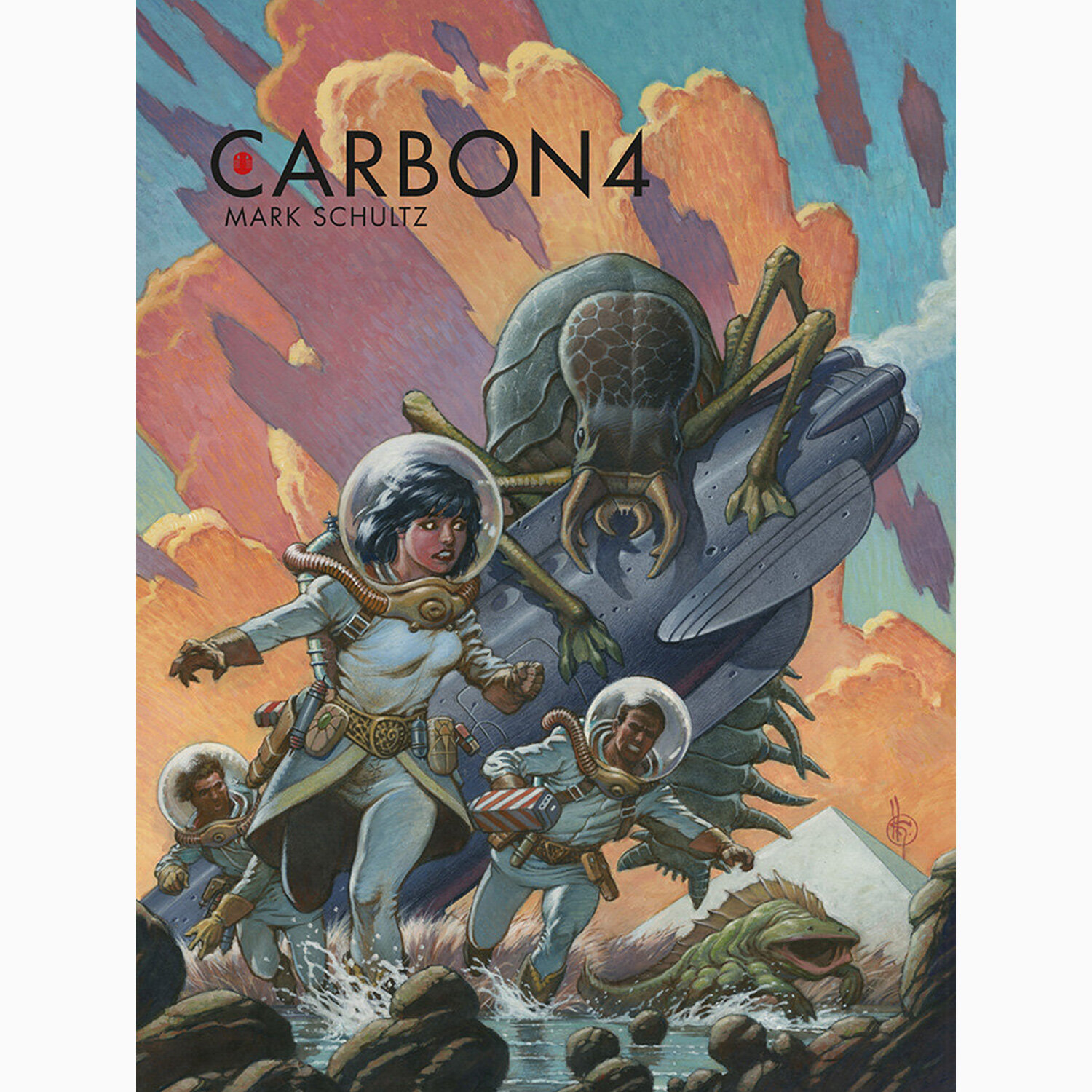
And coming full circle, are you working on anything Xenozoic-related?
[Laughs] Yes, as time and economics allow, I have been working on, for several years [now], a 66-page, I guess you'd call it a short graphic novel. It’s probably about two-thirds done. Again, I only work on it as time and economics allow. I have no schedule for getting it done–but some day...
Are you doing that in your pencil and ink style, or in a similar style to Storms at Sea or Carbon?
I'm doing it in traditional comic book brush and ink the way I did the original series. My goal is to keep it a black and white, or monochromatic, maybe like one color added story–to stay in tune with the earlier black and white stories.
No ETA of any kind on that?
No, I'm not giving any. Too many times in the past I've burned myself by giving educated guesses when I'd have something done and I’ve come nowhere near to hitting them. At this point in my life, if I haven't figured out how fast it takes me to get things done, it just isn't going to happen. I’ll just say it's done when it's done.



